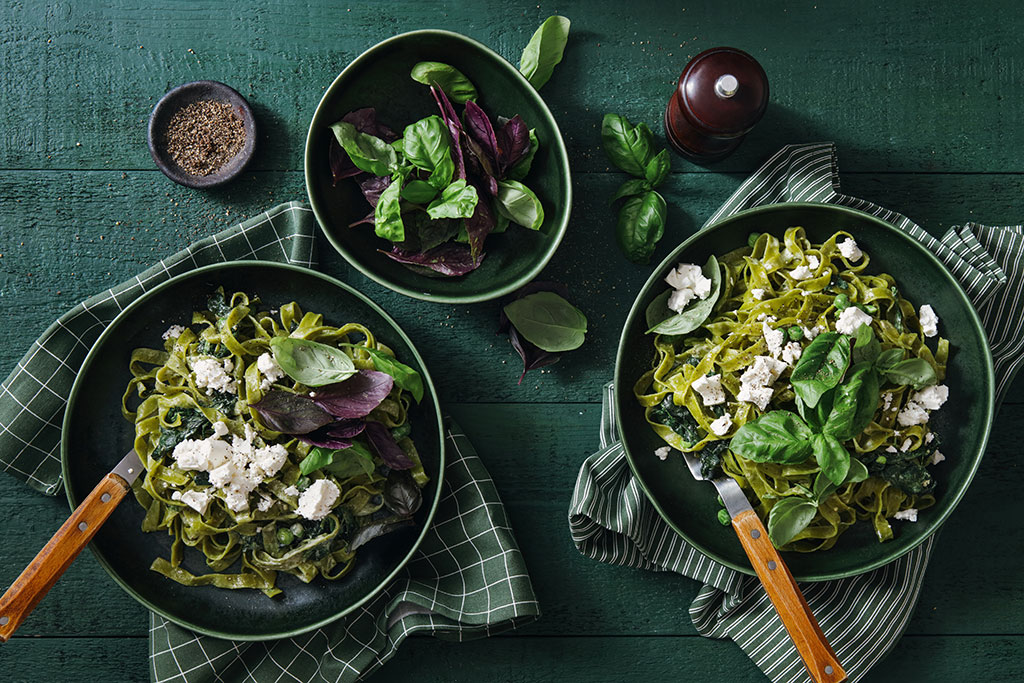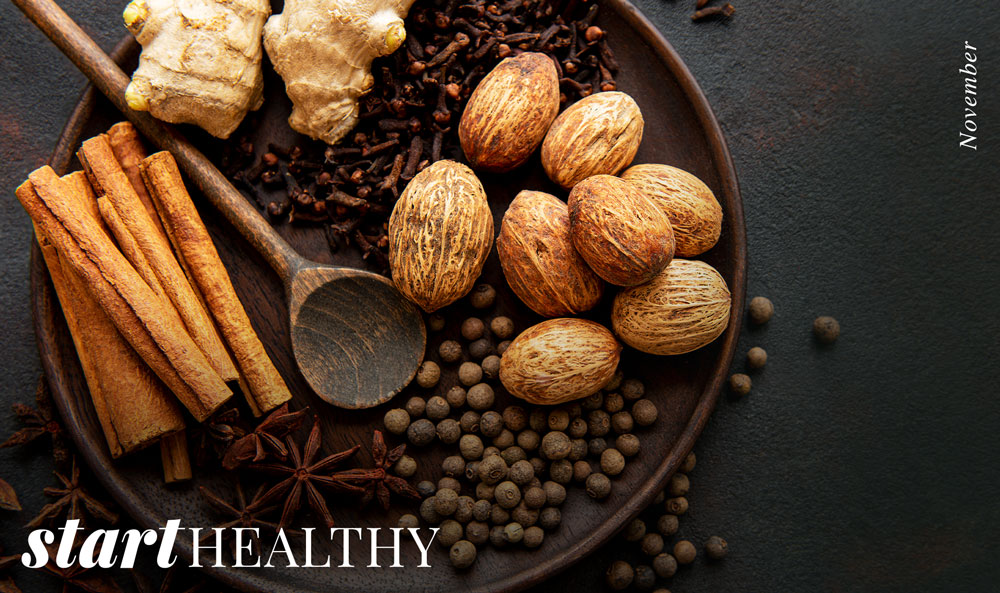The holiday season is quickly approaching, which means you may be focused on shopping and preparation. This issue of Start Healthy is here to help you continue to prioritize your well-being in an often hectic season with a guide to the health benefits of herbs and spices, a closer look at certain exercises you may want to avoid, and much more.
Amidst the holiday shopping frenzy, homemade gifting shines as a meaningful and cost-effective option. Inside, discover gift-giving tips to help you tap into your creativity and thoughtfulness and craft personalized items that are sure to be a hit with your loved ones.
Herbs and spices are a great way to add delicious flavors to your meals, but they’re also packed with antioxidants and essential vitamins and minerals. Find out how these natural seasonings can help prevent and treat diseases, reduce inflammation, and improve your overall health.
When it comes to working out, it’s important to tailor your exercises to your specific needs and abilities, especially if you have existing joint issues or back pain. This issue provides valuable insight into how certain routines may be detrimental to your well-being and offers alternatives you could give a try instead.
As 2023 nears its end, now is the perfect time to conduct a year-end financial review to better prepare yourself for the future. The enclosed guide outlines important steps for assessing your finances, including reviewing your budget and updating your insurance coverage, which may help set you up for a successful year ahead.
Here’s hoping you have a healthy, happy holiday season! As always, it’s a pleasure to send you this magazine.
’Tis the season for brands to excitedly email you with all their offerings and gift ideas. In fact, everywhere you turn you see notices to shop, shop, shop for the perfect presents for your friends and family. It can be a little overwhelming, especially if gift giving isn’t your love language or you don’t have a lot of extra money.
In this sea of options, the art of homemade gifts can be a life raft. Whether it’s a handcrafted candle or a tin of freshly baked cookies, the effort you put into creating such a gift demonstrates an inherent care and thoughtfulness that will go a long way. Follow these tips on all things homemade gifting to help you come up with the best way to celebrate the ones you love.

You don’t have to take up knitting just so you can make custom scarves for your friends. A homemade gift can be anything you create with another person in mind, whether you bake them something, curate a mixtape based on their musical taste, write them a poem, or even repot a cutting of a beloved plant.
Gifting also doesn’t have to be restricted to a concrete item. Some of the best gifts are born from people using their skills to help someone else. Perhaps you are great with a camera and could offer a portrait session, or maybe you have perfected meal prep and could write down easy recipes and a food shopping list for a busy friend. Are you handy? Offer to change light bulbs, fix that stubborn doorknob, or hang a chandelier. If you have access to a hose and a portable vacuum, pick up a loved one’s car to wash and detail. Though certain tasks may not feel like a lot to you, they can go a long way toward giving a boost to someone you care about.

Another important step of homemade gifting is spending some time thinking about the other person and what they enjoy. Do they have a sweet tooth? Are they a devoted plant parent? Imagine their home in your head, and notice any themes that arise. The more details you can remember, the easier it will be to identify an idea that might make a meaningful gift for them.
It’s also important to factor in the lifestyle and limitations of your loved ones. Some people curate the art and objects in their home carefully, so a surprise gift they are meant to display might not go over well. For this type of person, something edible would likely be a better choice. Conversely, if your giftee has a lot of food allergies and you are not 100 percent clear on them, stick with a gift that’s not meant to be eaten.
Now that you have a sense of your skill set and what your giftee might appreciate, it’s time to figure out how to match the two. Here are some examples to help get you started.
Gifts for a foodie

If your recipient loves a good baked good, fire up the oven and channel your inner Paul Hollywood. To craft multiple gifts, buy a few metal tins and bake batches of several different types of cookies to include. You can even get ambitious and try your hand at macarons, which can be made in a variety of flavors and colors that make your gift box pop.
Thanks to the popularity of charcuterie boards, little dips and spreads are also a great option for gifts, like this whiskey bacon jam that won an award from Taste of Home. Or whip up this mustard pretzel dip and package it with soft pretzel nuggets for a delightful snack gift.
For the chocoholics on your list, choose an assortment of finger foods like pretzel rods, nuts, graham crackers, and strawberries and coat them in melted chocolate. Use sprinkles or drizzles of white chocolate to give them a finished look.
Gifts for self-care

There is a reason DIY body scrubs are so popular—they are easy to make, they smell wonderful, and who doesn’t love smooth skin? Try this customizable recipe from Lexi’s Clean Kitchen, which includes a PDF of cute labels you can print out. To be kinder to plumbing, use jojoba or olive oil, as these two oils are more likely than others to remain in liquid form as they go down the drain. And opt out of coffee grounds and oatmeal unless you know your giftee has a drain cover that will keep those particles from going into their pipes.
Bath bombs are another great gift idea, and they’re very cost-effective if you’re planning to make a batch of them for several people. Find detailed instructions here on how to make ones that successfully stick together and fizz. Use lavender and chamomile oils for a relaxing end-of-the-day soak. For eco-friendly packaging, you can buy small paperboard boxes or wrap them individually with brown kraft paper.
When it comes to deciding on the right gift, don’t overthink the process too much. At the end of the day, it’s not the cost or even the result that will matter most—it’s the time, effort, and care you put into it.
You might not put much thought into the herbs and spices you use to flavor your meals, but these powerhouses can do more than add heat to your chilis, flavor your smoothies, or provide zing for your stir-fries. Long revered for their taste and pleasing aromas, these seasonings have also been shown to help prevent and treat disease, relieve pain, and improve mood. Plus, they are low in calories and can substitute for less-healthy additives like sugar and salt. Use this guide to help you take advantage of the many benefits these amazing natural flavorings have to offer.

While herbs and spices both come from plants, herbs are their leafy parts while spices are their dried flowers, fruit, seeds, or bark. You can use herbs fresh or dried and spices whole or ground, though whole spices, such as cinnamon sticks and peppercorns, will keep their flavor the longest.
However you prefer these seasonings, you can benefit from their numerous nutritional and health-promoting qualities. Most have high concentrations of antioxidants, natural compounds that can help lower inflammation in your body and possibly reduce your risk of developing illnesses like arthritis, cancer, diabetes, and heart disease. In addition, they contain vitamins and minerals that have potential benefits such as improving your bone strength, metabolism, and eye health and lowering your blood cholesterol and sugar levels.

Basil
This member of the mint family has many varieties, including sweet basil and Thai basil. It has both vitamin K, which can foster healthy bones and help wounds heal, and magnesium, a mineral essential to the health of your heart, brain, and musculoskeletal system. You can also use basil’s invigorating aroma to combat fatigue.
Try this recipe: Fra Diavolo Seafood Gnocchi
Black pepper
Derived from the peppercorn (the dried berry of the tropical Piper nigrum vine), black pepper is not only spicy and aromatic but also contains numerous vitamins and minerals. Plus, it can increase the amount of nutrients your body absorbs. Consider grinding whole peppercorns rather than using commercially ground pepper to get the most out of this spice’s health benefits.
Try this recipe: Black Pepper Bacon Pineapple Fried Rice

Cinnamon
Pleasantly fragrant, cinnamon is the inner bark of various Cinnamomum tree species. Whether ground or in stick form, it can be used as a delicious sugar substitute for your coffee, cereal, or stew to help you fight off both bacterial infections and viruses that cause colds and the flu.
Try this recipe: Apple-Cinnamon Instant Oatmeal
Cumin
Originally from the Middle East and India, iron-rich cumin is made from the seeds of the Cuminum cyminum plant. It’s popularly used in chilies and curries and may improve digestion and metabolism. It may even be helpful in managing diabetes since it can lower blood glucose levels.
Try this recipe: Charred Cumin Cauliflower with Tahini Honey
Oregano
This leafy herb originates from the Mediterranean region and is prevalent in Greek and Italian cuisines. Try mixing it with other fresh greens, in a vinaigrette, or in a pesto to take advantage of its ability to fight bacterial and viral infections, reduce inflammation, and lower blood sugar levels.
Try this recipe: Herb Tofu-Stuffed Peppers

Paprika
Often featured in Hungarian, Spanish, and Mexican cuisines, paprika is an orange- or red-hued spice made from ground dried peppers and can be sweet, hot, or smoky in flavor. Research shows paprika may soothe inflammation, reduce risk of cancer, and lower blood cholesterol levels.
Try this recipe: Harissa BBQ Beef
Parsley
Whether you prefer curly or flat leaf, munching on parsley can provide you with vitamins and minerals that may support bone and eye health and reduce your risk of heart disease. You can toss it in marinades and salad dressings or use it to garnish your seafood.
Try this recipe: Salmon Cakes with Side Salad
Rosemary
Delicious in beverages and on chicken and potatoes, rosemary has a distinctive woody fragrance and has been found to have antibacterial, antiviral, and antifungal properties. It may also augment metabolic health and help injuries heal faster.
Try this recipe: Savory Olive and Rosemary Bread Pudding

Sage
Native to the shores of the Mediterranean Sea, sage features an earthy aroma and a peppery flavor. It’s believed to help lower blood cholesterol and sugar levels, promote both brain and oral health, and mitigate menopausal symptoms. The scent of sage oil is also frequently used in aromatherapy.
Try this recipe: Sweet Peppers and Pork with Sage and Honey
Turmeric
This bright-gold spice is made by drying and often grinding the root of the Curcuma longa plant, which is known to have anti-inflammatory and illness- and infection-fighting abilities. You can savor this peppery-tasting spice in curries, on roasted vegetables, and in drinks like teas or smoothies.
Try this recipe: Pork Vindaloo over Basmati Rice
Whether you want to eat more nutritious foods or inject extra flavor into your favorite recipes, adding herbs and spices might just be the way to go.
Whether you prefer a jog at your local park or lifting weights in a stylish fitness center, there’s no question that challenging your body with a regular exercise routine can offer a broad range of benefits. These perks include sustained cardiovascular health, weight loss, and a mood boost. However, it’s important to know that not all exercise may necessarily be good—or at least, not good for you.
Depending on your body’s unique needs, limitations, and conditions—as well as your personal fitness goals—a high-intensity workout such as barbell squats may not be ideal. Worse, the wrong exercise may actually cause you harm. To stay active and protect your well-being, find the right types of exercises for you, then craft a balanced fitness routine around them. If you identify with any of the following challenges, consider avoiding certain workouts or swapping them out for alternatives instead.

According to the CDC, a whopping 24 percent of American adults experience arthritis, just one of the many conditions that can affect joint health, cause pain and stiffness, and possibly even reduce your body’s mobility.
However, this doesn’t mean that one in four Americans should avoid exercise altogether. In fact, studies have shown that moderate exercise can actually help fight symptoms of joint issues. Just avoid high-impact exercises that would require your joints to absorb large amounts of weight or pressure. These may include running, high-intensity interval training (HIIT), and powerlifting.

Try instead: Low-impact exercises like walking and yoga, which are heart healthy yet simple enough for many people with mobility issues. If you are going to perform resistance exercises like squats and bicep curls, use a medicine ball or small kettlebell in lighter weights to manage your joint impact.
Also, be sure to listen to your body. As the Orthopaedic Associates of Michigan recommends, “If you experience average to intense pain during your workout, stop . . . This might be a sign that you are experiencing joint inflammation or maybe even joint damage.” Continually check how your joints feel throughout each session, even when engaging in light exercise.

Your neck and back are two of the most excruciating and potentially debilitating places you can experience pain. If you struggle with conditions such as fibromyalgia or spinal stenosis, have chronic or occasional back soreness, or are recovering from a neck injury, you may feel as if even slight movements pose a huge risk. Reach for something across your desk: pain. Bend over to tie your shoe too quickly: pain. Naturally, this can make you nervous about engaging in a challenging exercise routine.
Unfortunately, as the Spine Institute of North America (SINA) confirms, many common workouts can potentially worsen back or neck pain. For instance, offenders like sit-ups, squats, and burpees may apply additional stress to your backbone. Taking time to warm up and ensure you practice proper form can reduce your risk of experiencing any side effects. However, depending on your level of back or neck pain, it may be advisable to avoid these risky routines altogether.

Try instead: These gentle, guided exercises courtesy of the Cleveland Clinic. Its recommendations include calisthenics like side bends and stretches like child’s pose. When performed properly and paired with guided breathing, such exercises can help release tension along your spine while also keeping you active.
SINA further suggests that “you should perform gentle exercises that stretch the muscles around your back but don’t put excess pressure on them.” If you experience only occasional pain or discomfort, assess how your neck and back feel before your workout, and reserve more grueling workouts for days when you feel strong and pain-free.

Success in fitness depends on the amount of effort you exert, which means that if you’re unmotivated to exercise, you’re unlikely to reap much from your trip to the fitness center. Many people relish exercising for the endorphins it releases; these happy chemicals can provide a strange feeling of satisfaction even after going through a strenuous workout. But for others, this mood boost isn’t enough to make maintaining a high-stress exercise program worth it.
Workouts like running and weightlifting require major exertion, are repetitive, and tend to be solitary—all of which can lead to boredom. Without the proper motivation, you may end up cutting your sessions short or skipping them altogether, especially if you have a busy lifestyle that juggles many work and family responsibilities.

Try instead: A routine with built-in variety and a splash of recreation, such as swimming, dancing, or long walks in enjoyable scenery. Making your exercises entertaining can sustain your motivation, which will help you achieve both your short- and long-term fitness goals. For even more inspiration to get active, invite a friend to exercise with you. If you fold a social occasion into your exercise session, you may be more likely to show up at the gym. You could also enroll in a high-energy, guided fitness class like Zumba or spinning for built-in accountability and hype.
*Always consult your doctor for questions about your health or before beginning a new exercise routine.
As December approaches, now is a great time to take stock of your financial situation and prepare for the year ahead. A year-end review may provide valuable insights, enabling you to make necessary financial adjustments that can help set you up for success in the future. To assist you with this process, here are a few important steps for assessing your finances.

Initiate your planning process by combing through your annual income and expenditures and evaluating how well you saved. Review your income sources—including salaries, bonuses, investments, and other revenue streams—and analyze your expenses, such as by checking your credit card statements, to examine the distribution of your income throughout the year. By distinguishing between essential and discretionary spending, you can identify the areas where you either maintained budgetary discipline or veered off track. This can help you fine-tune your financial habits for the upcoming year and better commit to your goals and a more efficient allocation of resources.

Managing debt and maintaining a healthy credit profile are key components of taking care of your financial well-being. Before the year ends, check your credit reports for errors or signs of identity theft so you can make any necessary disputes about inaccurate information. These reports will also give you an idea of what may be currently impacting your credit score, which can help you see how you might be able to improve it in the coming year and, in turn, open doors for better financial opportunities and loan terms.
Further, check in on any outstanding debt, including credit card balances, student loans, mortgages, and other personal loans. Notice how much you paid them down this year, and determine if you can better target your principal balances going forward. Consider trying either the avalanche method (targeting your highest interest-rate debt first) or snowball method (prioritizing your smallest debts) to help pay them off as quickly as possible.

Though Tax Day isn’t for several more months, you may want to start prepping for it sooner rather than later. If you had any big life changes this year, like a marriage, divorce, or birth of a child, assess how it may impact your tax withholdings and if you need to update your status. Work on gathering necessary documents, including your tax return from the previous year and receipts for any charitable donations, business expenses, or other tax-deductible expenses. If you have a complex financial situation, you may want to consult with a tax professional to optimize your strategy. Also, make sure that your employer has the correct address so you can receive your tax forms on time. By completing each of these steps now, you can help alleviate some of the stress you may otherwise feel come tax season.

Insurance plays an important role in protecting yourself and your loved ones. Take the time to review your existing insurance policies, including health, life, auto, and homeowners or renters insurance, and determine whether your coverage levels are sufficient or if there are any potential gaps in your protection. Changes in your personal circumstances may require adjustments to your insurance, so research and compare providers to be certain that you have the best coverage at the most competitive rates.

While estate planning may not be a topic most people enjoy contemplating, it is a vital part of ensuring your loved ones are taken care of. Review and update your will, any trusts, and your beneficiaries for your life insurance and retirement accounts. Make sure each one accurately reflects your current circumstances. This is also a good time to evaluate your need for additional estate planning documents, such as powers of attorney or health care directives, which provide guidance and legal authority in critical situations. Consider consulting with an estate attorney to better determine what documents you should acquire according to your specific needs.

Finally, reflect on your past financial goals and achievements, celebrating your successes and learning from any setbacks. This can assist you in defining specific and measurable financial goals for the upcoming year, whether that includes saving for a down payment on a house, starting an emergency fund, or investing in your education or business. Whatever your goals may be, make them realistic and break them down into actionable steps you can follow. Creating a plan and tracking your progress will help keep you accountable and motivated to pursue them.
Financial planning is an ongoing process, so be sure to regularly review your finances throughout the year and adjust your strategies and long-term goals as your circumstances change.










